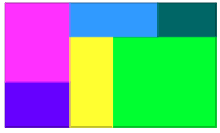Guillotine problem

A partition which can be obtained by guillotine cutting
The guillotine problem is a problem in combinatorial geometry and in printing.
Closely related to packing problems and specifically to cutting stock and bin packing problems,[1] it is the question of how to get the maximum number of sheets of one rectangular size out of a larger sheet, only orthogonal cuts that bisect one component of the sheet are allowed, as on a paper cutting guillotine.
The Guillotine problem is important in glass machining. Glass sheets are scored along horizontal and vertical lines and then broken along these lines to obtain smaller panels.
Like the cutting stock problem, it is NP hard, but various approximate and exact solutions have been devised.[2][3][4]
References
- ↑ Gerhard Wäscher, Heike Haußner, Holger Schumann, An improved typology of cutting and packing problems, European Journal of Operational Research 183 (2007) 1109–1130,
- ↑ Michael L. McHale, Roshan P. Shah Cutting the Guillotine Down to Size. PC AI magazine, Volume 13, Number 1 Jan/Feb 99. http://www.amzi.com/articles/papercutter.htm
- ↑ M. Hifi, R. M’Hallah and T. Saadi, Approximate and exact algorithms for the double-constrained two-dimensional guillotine cutting stock problem. Computational Optimization and Applications, Volume 42, Number 2 (2009), 303-326, DOI: 10.1007/s10589-007-9081-5
- ↑ François Clautiaux, Antoine Jouglet, Aziz Moukrim, A New Graph-Theoretical Model for the Guillotine-Cutting Problem. INFORMS Journal on Computing October 2011 ijoc.1110.0478 pp. 1–15
This article is issued from
Wikipedia.
The text is licensed under Creative Commons - Attribution - Sharealike.
Additional terms may apply for the media files.